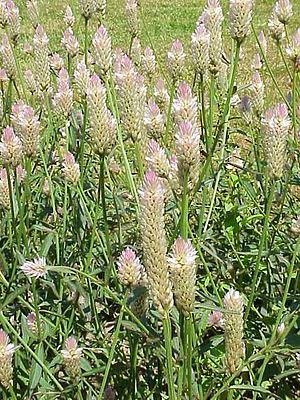Note: This is a project under development. The articles on this wiki are just being initiated and broadly incomplete. You can Help creating new pages.
Difference between revisions of "Celosia argentea"
| Line 5: | Line 5: | ||
===Food=== | ===Food=== | ||
| − | Celosia argentea can be used in food. Young leaves are cooked as vegetable and seeds are used in lapshi - a sweet preparation. | + | Celosia argentea can be used in food. Young leaves are cooked as vegetable and seeds are used in lapshi - a sweet preparation<ref name="Forest foods of Western Ghat"/>. |
==Parts Used== | ==Parts Used== | ||
| Line 32: | Line 32: | ||
===Nutritional components=== | ===Nutritional components=== | ||
| − | Celosia argentea contains the Following nutritional components like Vitamin-A, B2 and C; Calcium, Iron, Magnesium, Manganese, Phosphorus, Potassium, Sodium, Zinc. | + | Celosia argentea contains the Following nutritional components like Vitamin-A, B2 and C; Calcium, Iron, Magnesium, Manganese, Phosphorus, Potassium, Sodium, Zinc<ref name="Forest foods of Western Ghat"/>. |
==Habit== | ==Habit== | ||
| Line 57: | Line 57: | ||
==Cultivation Details== | ==Cultivation Details== | ||
| − | A plant of the tropics, able to be grown also in the subtropics and warm temperate zones. Celosia argentea is available through September to January<ref name=" | + | A plant of the tropics, able to be grown also in the subtropics and warm temperate zones<ref name="How to plant/cultivate"/>. Celosia argentea is available through September to January<ref name="Forest foods of Western Ghat"/> |
==Commonly seen growing in areas== | ==Commonly seen growing in areas== | ||
Revision as of 11:28, 27 October 2021
Common cockscomb is an erect, usually much-branched, annual plant. It grows upto 40 - 200cm tall. This species is one of the most promising leaf crops for cultivation in poor or variable growing conditions. It is sometimes cultivated in western tropical Africa, and a few other areas of the tropics, for its edible leaves. It's family is Amaranthaceae.
Contents
- 1 Uses
- 2 Parts Used
- 3 Chemical Composition
- 4 Common names
- 5 Properties
- 6 Habit
- 7 Identification
- 8 List of Ayurvedic medicine in which the herb is used
- 9 Where to get the saplings
- 10 Mode of Propagation
- 11 Cultivation Details
- 12 Commonly seen growing in areas
- 13 Photo Gallery
- 14 References
- 15 External Links
Uses
Diarrhoea, Bloodshot eyes, Blurring of vision, Cataracts, Hypertension, Diabetes, Snakebites, Colic, Gonorrhoea, Eczema.
Food
Celosia argentea can be used in food. Young leaves are cooked as vegetable and seeds are used in lapshi - a sweet preparation[1].
Parts Used
Chemical Composition
Common names
| Language | Common name |
|---|---|
| Kannada | Anne soppu, Hanne soppu |
| Hindi | Gadrya, Garke |
| Malayalam | |
| Tamil | Makili-k-kirai |
| Telugu | Gurugu |
| Marathi | Kurdu |
| Gujarathi | |
| Punjabi | |
| Kashmiri | |
| Sanskrit | Mayurasikha |
| English | Silver Cockscomb, White Cockscomb |
Properties
Reference: Dravya - Substance, Rasa - Taste, Guna - Qualities, Veerya - Potency, Vipaka - Post-digesion effect, Karma - Pharmacological activity, Prabhava - Therepeutics.
Dravya
Rasa
Guna
Veerya
Vipaka
Karma
Prabhava
Nutritional components
Celosia argentea contains the Following nutritional components like Vitamin-A, B2 and C; Calcium, Iron, Magnesium, Manganese, Phosphorus, Potassium, Sodium, Zinc[1].
Habit
Identification
Leaf
| Kind | Shape | Feature |
|---|---|---|
| Narrow | Elliptic | Strongly veined, 5-15cm long |
Flower
| Type | Size | Color and composition | Stamen | More information |
|---|---|---|---|---|
| Slender | 1-13cm | Pink | Rose flowers heads have a metallic sheen | {{{5}}} |
Fruit
| Type | Size | Mass | Appearance | Seeds | More information |
|---|---|---|---|---|---|
Other features
List of Ayurvedic medicine in which the herb is used
Where to get the saplings
Mode of Propagation
Cultivation Details
A plant of the tropics, able to be grown also in the subtropics and warm temperate zones[5]. Celosia argentea is available through September to January[1]
Commonly seen growing in areas
Open moist places, Open areas and weed of crop fields.
Photo Gallery
References
- ↑ 1.0 1.1 1.2 Cite error: Invalid
<ref>tag; no text was provided for refs namedForest foods of Western Ghat - ↑ [Chemistry]
- ↑ Karnataka Aushadhiya Sasyagalu By Dr.Maagadi R Gurudeva, Page no:11
- ↑ Kappatagudda - A Repertoire of Medicianal Plants of Gadag by Yashpal Kshirasagar and Sonal Vrishni, Page No. 120
- ↑ Cultivation
External Links
- Pages with reference errors
- Ayurvedic Herbs known to be helpful to treat Diarrhoea
- Ayurvedic Herbs known to be helpful to treat Bloodshot eyes
- Ayurvedic Herbs known to be helpful to treat Blurring of vision
- Ayurvedic Herbs known to be helpful to treat Cataracts
- Ayurvedic Herbs known to be helpful to treat Hypertension
- Ayurvedic Herbs known to be helpful to treat Diabetes
- Ayurvedic Herbs known to be helpful to treat Snakebites
- Ayurvedic Herbs known to be helpful to treat Colic
- Ayurvedic Herbs known to be helpful to treat Gonorrhoea
- Ayurvedic Herbs known to be helpful to treat Eczema
- Herbs with Leaves used in medicine
- Herbs with Young shoots used in medicine
- Herbs with Seeds used in medicine
- Herbs with common name in Kannada
- Herbs with common name in Hindi
- Herbs with common name in Tamil
- Herbs with common name in Telugu
- Herbs with common name in Marathi
- Herbs with common name in Sanskrit
- Herbs with common name in English
- Habit - Annual
- Index of Plants which can be propagated by Seeds
- Herbs that are commonly seen in the region of Open moist places
- Herbs that are commonly seen in the region of Open areas and weed of crop fields
- Herbs
- Pages without herbs images





